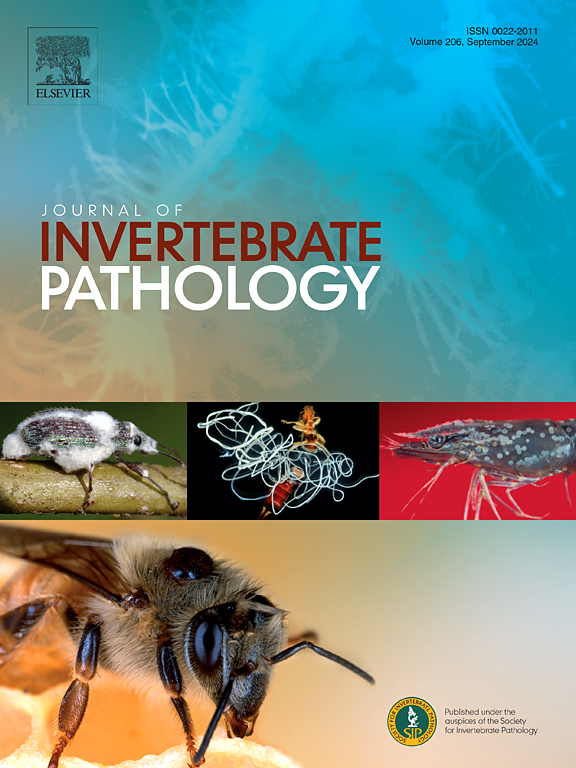Identification of two novel bacterial strains as the putative cause of black mouth disease in farmed Strongylocentrotus intermedius
IF 2.4
3区 生物学
Q1 ZOOLOGY
引用次数: 0
Abstract
Black mouth disease (BMD) serves as the principal bacterial affliction of the cultivated sea urchin Strongylocentrotus intermedius, commonly breaking out in spring and winter. In January 2024 (winter), two predominant bacterial strains (SIBMPM04 and SIBMIT01) closely associated with BMD were isolated from the peristomial membrane and intestine of diseased S. intermedius from a farming area in the Yellow Sea of China. Characterization analyses, including Gram staining, morphology determination, artificial infection tests, and metabolic characterization, were then performed on SIBMPM04 and SIBMIT01. Both SIBMPM04 and SIBMIT01 belonged to the genus Vibrio, and 16S rRNA identification and phylogenetic analysis showed that SIBMPM04 shared a 98.68 % similarity with Vibrio bathopelagicus and that SIBMIT01 shared a 98.93 % similarity with Vibrio atypicus. Antimicrobial susceptibility tests indicated that both SIBMPM04 and SIBMIT01 were sensitive to chloramphenicol, florfenicol, imipenem, kanamycin, levofloxacin and polymyxin B. SIBMPM04 was sensitive to gentamycin and amikacin, and SIBMIT01 was sensitive to norfloxacin and sulfamethoxazole. Metabolic characterization data showed that SIBMPM04 and SIBMIT01 shared similar metabolic characteristics. Laboratory-based artificial infection tests showed that sea urchins infected with either SIBMPM04 or SIBMIT01 alone exhibited typical pathological symptoms of BMD in a dosage-dependent manner, and synergistic pathogenicity was observed when both bacterial strains were present. The observations from this study not only enrich information on these pathogens in sea urchins but also support the hypothesis that BMD may be induced by the synergistic action of multiple bacterial strains in sea urchins, leading to the rapid progression of disease symptoms.

养殖中间圆梭菌黑口病推定病原的两种新菌株的鉴定
黑口病(BMD)是养殖海胆中圆梭菌(Strongylocentrotus intermedius)的主要细菌疾病,通常在春冬季爆发。2024年1月(冬季),从黄海某养殖区患病中间链球菌的胃周膜和肠道中分离到两株与BMD密切相关的优势菌株SIBMPM04和SIBMIT01。然后对SIBMPM04和SIBMIT01进行表征分析,包括革兰氏染色、形态学测定、人工感染试验和代谢表征。SIBMPM04和SIBMIT01均属于弧菌属,16S rRNA鉴定和系统发育分析表明,SIBMPM04与bathopelagicus弧菌的相似性为98.68%,SIBMIT01与非典型弧菌的相似性为98.93%。药敏试验结果表明,SIBMPM04和SIBMIT01对氯霉素、氟苯尼考、亚胺培南、卡那霉素、左氧氟沙星、多粘菌素b敏感,SIBMPM04对庆大霉素、阿米卡星敏感,sibmpm01对诺氟沙星、磺胺甲恶唑敏感。代谢表征数据显示,SIBMPM04和SIBMIT01具有相似的代谢特征。实验室人工感染试验表明,单独感染SIBMPM04或SIBMIT01的海胆均表现出典型的BMD病理症状,且呈剂量依赖关系,两种菌株同时存在时均具有协同致病性。本研究的观察结果不仅丰富了海胆中这些病原体的信息,而且支持了多种细菌菌株在海胆中协同作用诱导BMD,导致疾病症状快速进展的假设。
本文章由计算机程序翻译,如有差异,请以英文原文为准。
求助全文
约1分钟内获得全文
求助全文
来源期刊
CiteScore
6.10
自引率
5.90%
发文量
94
审稿时长
1 months
期刊介绍:
The Journal of Invertebrate Pathology presents original research articles and notes on the induction and pathogenesis of diseases of invertebrates, including the suppression of diseases in beneficial species, and the use of diseases in controlling undesirable species. In addition, the journal publishes the results of physiological, morphological, genetic, immunological and ecological studies as related to the etiologic agents of diseases of invertebrates.
The Journal of Invertebrate Pathology is the adopted journal of the Society for Invertebrate Pathology, and is available to SIP members at a special reduced price.

 求助内容:
求助内容: 应助结果提醒方式:
应助结果提醒方式:


